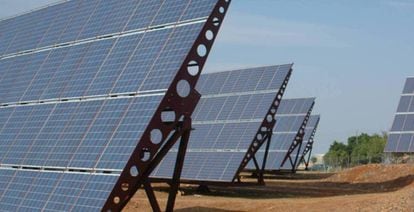The photovoltaic parasol: Spanish engineer develops energy-generating textiles
Ana Rodes of the AITEX research institute has integrated solar cells into flexible materials that pave the way for cheaper, more sustainable ways of extracting energy from the sun
/cloudfront-eu-central-1.images.arcpublishing.com/prisa/YOYN7FF6QZGS3APLYIBEGHO3ZE.jpg)
A 30-year-old Spanish engineer has developed a way to integrate solar cells into textiles, paving the way for cheap energy generation through flexible materials such as awnings or parasols.
Ana Rodes, a native of Alcoy in the Valencia region, is head of the sustainability and circular economy technical department at AITEX, a leading research group that works to incorporate emerging technologies into the textile industry.
“Cities have a multitude of structures with textiles that are exposed to the sun, such as awnings, tents, parasols, pergolas and canopies,” says Rodes. “But so far, these have not been used to generate energy due to the limitations of traditional solar panels, made of crystalline silicon.”

Conventional panels typically require rigid support structures. They are also very sensitive to the shade and to temperature variations, they require large spaces for installation, and production costs are high, making them off-limits for many everyday applications that require energy use.
So this industrial engineer got to work on a more affordable design that adapts to both flat and curved shapes, can be easily carried from place to place, and works in all kinds of weather.
Her research is based on thin-film panels, which are light, flexible and semi-transparent. Until now, she explains, these photovoltaic cells had been integrated into glass, ceramic, building façades and roofs. But her project has combined them with textiles instead.
Sustainable energy production
Rodes believes that her system will be useful for activities that have no easy access to the electricity grid but have significant exposure to sunlight, such as agriculture.
“Faced with one of the biggest challenges on the planet, the depletion of natural resources, which is already happening, the study proposes several scenarios to make the most of solar energy in a more sustainable way – through photovoltaic tents, solar sails or canopies for boats, camping tents, greenhouses, billboards and scaffolding coverings,” she explains.
What began as the final project for her master’s degree at Valencia Polytechnic University (UPV) ended up as a prototype “that can feed an entire LED lighting system and charge a cellphone.”
Her work is part of a larger project developed with support from the Valencia government’s sustainable economy department. “The goal of this type of R&D [research and development] projects is to contribute to the industrial progress of the textile sector through the creation of knowledge,” says Rodes, who earned a prize last year for the best final project of the UPV’s Textile Engineering postgraduate program.
English version by Susana Urra.

/cloudfront-eu-central-1.images.arcpublishing.com/prisa/ETE3PDNZSTB2LMTK26RHKIVUBI.jpg)










































